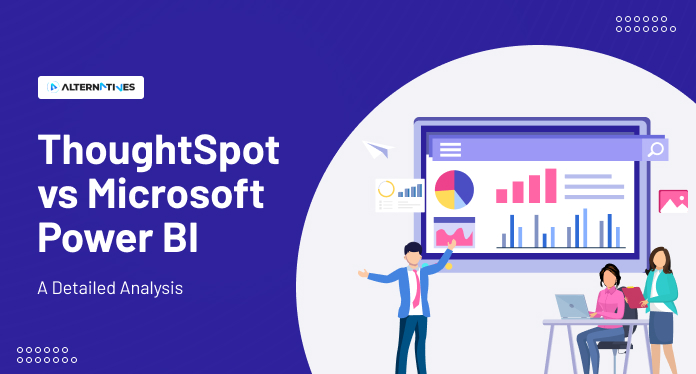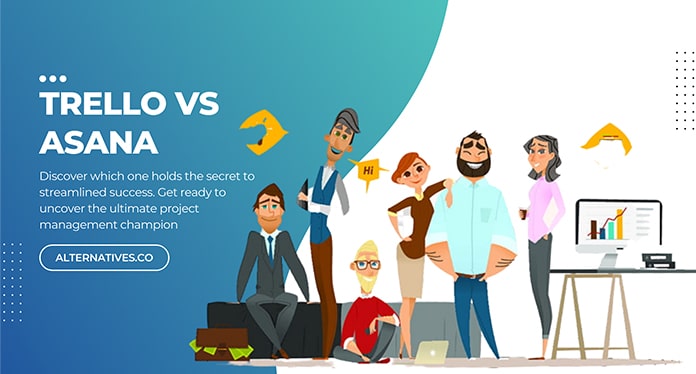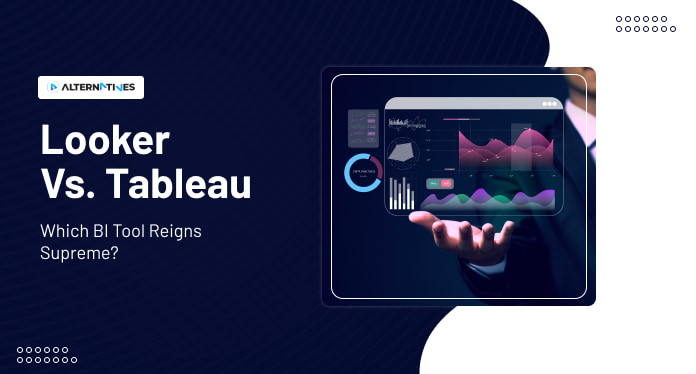Thoughtspot Vs Power Bi: A Detailed Analysis

ThoughtSpot and Power BI are two of the most popular business intelligence (BI) solutions on the market today. Both products offer a range of features that can help businesses make informed decisions and drive better outcomes. This article takes an in-depth look at how ThoughtSpot and Power BI compare in terms of scalability, pricing, data visualization, data preparation and modeling, natural language querying, AI and machine learning, security and governance, integrations and APIs, ease of use, and support. We will also review customer feedback for each solution to get a better understanding of which one is best suited to meet your needs. By the end of this article, you should have an informed opinion on which BI solution is right for you.
ThoughtSpot is the more cost-efficient option with its subscription model, and AI and Machine Learning are revolutionizing the way people interact with data.
Overview Of Thoughtspot And Power Bi
Looking for an easy way to compare two top business intelligence solutions? Check out this overview of ThoughtSpot and Power BI!
Both products offer great scalability, making them suitable for businesses of all sizes. ThoughtSpot is especially well-known for its user experience, featuring a powerful search engine that allows users to type in natural language questions to retrieve data quickly. It also offers flexible deployment options: customers can choose from cloud or on-premise installations depending on their needs.
On the other hand, one of the main advantages offered by Power BI lies in its diverse range of data connectors. This makes it easier and faster to connect multiple sources and perform comprehensive analysis on large datasets. Additionally, creating custom dashboards becomes very straightforward with the drag-and-drop functionality provided by Power BI’s dashboard creation toolkit.
When it comes to data sharing, both ThoughtSpot and Power BI provide secure access management features so companies can control who has permission to view certain information within their organization. Finally, both solutions are highly scalable meaning they will be able to grow as your company expands over time.
Scalability And Pricing
Comparing scalability and pricing, it’s clear that ThoughtSpot is the more cost-efficient option. With its subscription model, users can easily pay for only what they need rather than having to purchase a fixed package of features or capacity as with the pricing of Power BI. This makes it easier for organizations to manage their costs while still taking advantage of the benefits offered by both tools.
When looking at feature comparison between ThoughtSpot and Power BI, there are some limitations in terms of scalability when using Power BI due to its enterprise use cases. Features such as advanced analytics capabilities like machine learning and natural language processing may be limited on the lower tier plans, making them unsuitable for larger organizations that require higher levels of scalability. On the other hand, the ThoughtSpot pricing model offers no such limitation when it comes to scalability or features regardless of how many users you have subscribed.
Finally, user experience also plays an important part when considering these two options. Both offer powerful search capabilities plus AI-driven insights that make exploring data easier even for novice users but Thinking Spot takes this one step further with its 'Natural Language Search' technology that allows users to ask questions about their data in plain English. In addition, ThoughtSpot provides better performance in terms of loading time and query execution speed compared to PowerBI all adding up to a smoother overall user experience.
Data Visualization And Discovery
Data visualization and discovery enable users to quickly uncover insights from their data, making it easier to make informed decisions.
ThoughtSpot and Power BI are two popular business intelligence (BI) platforms that feature a range of powerful data exploration and user interface tools for visualizing data.
Both offer comprehensive reporting capabilities with the ability to create highly customizable dashboards while also offering a wide variety of chart types and other ways to represent data visually.
ThoughtSpot offers an intuitive user interface for creating charts, graphs, maps, tables, and more. It makes it easy to explore your datasets by providing sophisticated search-based analytics tools as well as guided pathways for discovering insights in complex datasets. Additionally, its dashboard design allows users to easily incorporate multiple datasets into one interactive view.
Power BI is renowned for its robust library of visuals, allowing users to find just about any type of chart or graph they need. Its drag-and-drop functionality makes it simple to configure reports without requiring technical knowledge or skill level in coding languages such as R or Python. Furthermore, Power BI's natural language processing enables users to ask questions using plain English syntax which then produces visualizations based on the answers provided.
All these features allow organizations to access real-time information quickly and accurately so they can make better decisions faster than ever before.
Data Preparation And Modeling
Data Preparation And Modeling are essential processes for leveraging data to generate actionable insights, allowing organizations to make informed decisions quickly and accurately. It is the foundation upon which all other analytics activities rest.
Data quality, cleaning, transformation, warehousing, and mining play an important role in effective data preparation and modeling.
ThoughtSpot and Power BI are two popular tools used by companies of different sizes to enable data preparation and modeling tasks. ThoughtSpot provides users with a powerful search-based user interface that allows them to explore their data in real-time without having to write complex SQL queries or build complicated models. In addition, it has advanced features such as automatic clustering of similar values into groups for faster exploration.
Power BI, on the other hand, offers a more traditional environment where users can create visualizations quickly using its drag-and-drop feature while also being able to manipulate datasets through formulas or calculations written in DAX (Data Analysis Expressions).
The following table outlines some key differences between ThoughtSpot vs PowerBI for preparing and analyzing data:
| Feature | ThoughtSpot | PowerBI |
| Dashboard Design | Intuitive Search | Drag & Drop |
| Data Cleaning | Simple | Advanced |
| Data Transformation | Automated | Manual |
Natural Language Querying
Natural language querying provides a more natural way to interact with data, allowing users to ask questions about their data using plain language instead of complex queries.
ThoughtSpot and Power BI both offer natural language querying capabilities that enable users to quickly gain insights from their data without having to write long, complicated queries.
ThoughtSpot's natural language query engine uses automatic summarization techniques such as Natural Language Processing (NLP) and Text Classification for a better understanding of the user’s intent behind each search query. It also offers voice recognition powered by speech-to-text algorithms and sentiment analysis technology to further improve its accuracy. This enables it to understand various nuances in different languages and dialects, making it an ideal solution for multi-cultural organizations.
Power BI's natural language querying is supported by Microsoft's Q&A feature which allows users to type or speak their questions into the platform in conversational English. The system then interprets the question and runs the appropriate searches against your dataset before returning results in easy-to-understand visualizations and tables. Its ability to generate powerful visuals makes it a great tool for garnering deeper insights from your data within seconds.
AI And Machine Learning
Artificial Intelligence (AI) and Machine Learning are revolutionizing the way people interact with data, enabling them to make faster, more informed decisions.
When it comes to ThoughtSpot and Power BI, both tools have integrated AI capabilities that can help businesses gain insights into their data quickly. However, there is a difference in how they leverage this technology to provide value for users.
ThoughtSpot's natural language search capability uses AI algorithms to understand user queries and then surfaces relevant results from its own datasets or other sources such as Hadoop or Excel spreadsheets. This allows users to explore their data without needing any prior knowledge of SQL or programming languages.
On the other hand, Power BI similar to its various competitors focuses on providing predictive analysis through machine learning models such as regression and clustering. These models can be used for forecasting future trends based on historical data patterns which helps business leaders plan accordingly.
When considering AI and machine learning technologies, organizations must also take into account ethical considerations related to privacy and security as well as potential challenges associated with big data management, automation benefits, and opportunities for data mining/discovery.
As shown in the table below, each tool offers certain advantages when it comes to using these powerful technologies:
ThoughtSpot:
- – Natural Language Query Support
- – Data Exploration Without Prior Knowledge of Programming Languages
- – Real-Time Insights Into Data Analytics Workflows & Insight Discovery Processes
Power BI:
- – Predictive Analysis & Forecasting
- – Ease of Use & Visualization Tools
- – Advanced Security Features To Protect Sensitive User Data
Security And Governance
The security and governance of data are integral to the successful implementation of AI and machine learning technologies, requiring organizations to consider both ethical considerations and potential challenges associated with big data management.
For instance, when using ThoughtSpot or Power BI for business intelligence purposes, it is important to ensure that all data processing activities adhere to a set of established security protocols in order to protect sensitive information from unauthorized access and misuse.
To this end, certain measures must be implemented such as encryption solutions for stored data, authentication protocols for user access control, restrictive user permissions based on roles within an organization, audit logging capabilities to track user activity, and regular monitoring of system logs.
In addition to these technical aspects, there should also be corresponding policies in place that clearly define how personal data can be collected and used across various departments within an enterprise.
Overall, ensuring effective security practices through thought leadership initiatives is essential if businesses wish to successfully leverage the power of AI/ML-based technologies like ThoughtSpot or Power BI. By doing so they will not only safeguard their own interests but those of their customers as well.
Integrations And APIs
Integrating AI/ML-based technologies with existing systems and applications can help organizations maximize their potential for data-driven insights.
ThoughtSpot and Power BI are two of the leading analytics solutions in the market, but they differ significantly when it comes to integrations and APIs.
ThoughtSpot like its numerous other alternatives offers a wide range of integrations that allow users to easily connect various types of data sources such as databases, text files, web services, spreadsheets, etc.
Additionally, ThoughtSpot also provides cloud connectivity and automation capabilities through its API access which allows users to quickly integrate their own custom scripts with the platform.
Furthermore, ThoughtSpot also provides support resources including technical training courses and documentation that make it easier for users to get up and running quickly.
Power BI on the other hand is focused more on traditional integration approaches that use direct connectors to specific data sources like SQL Server or Oracle.
While this approach does offer some advantages in terms of speed and performance compared to generic APIs provided by ThoughtSpot, it lacks flexibility since most of these connectors only work with certain versions of software or hardware platforms.
Furthermore, Power BI's limited API access means that users will have less control over how their data is integrated into the system.
Lastly, there are fewer support options available than those offered by ThoughtSpot making it difficult for new users to get started without prior knowledge or experience.
Ease Of Use And Support
Ease of use and support are critical criteria for deciding on the best AI/ML-based technology to meet an organization’s needs. ThoughtSpot and Power BI both have strong offerings in these areas, although they differ in some key respects as well.
When it comes to user experience, ThoughtSpot provides a more intuitive interface with tools that make data analysis easier than ever before. Additionally, its customization options offer users more control over how their data is displayed and analyzed.
On the other hand, Power BI has a larger library of templates and graphics for creating visually appealing dashboards. However, this can be difficult to navigate without proper training resources.
Both products also provide access to cloud infrastructures such as AWS or Azure, while offering different levels of accessibility options. ThoughtSpot enables easy integration with various systems including Salesforce CRM whereas Power BI allows direct connections with popular applications like Google Sheets or Excel spreadsheets.
Ultimately, selecting the right product depends on specific organizational needs and preferences regarding ease of use and support services offered by each technology platform.
Reviews Of Thoughtspot And Power Bi
Comparing the user experience and support offerings of ThoughtSpot and Power BI can be a daunting task, but luckily there are plenty of reviews available to help inform your decision.
Here are some key points to consider when evaluating these two platforms:
User Feedback – When conducting a review of ThoughtSpot, it’s crucial to look at what other users have had to say about their experience. This includes assessing their ease of use, customer service, and feature set. Reviews provide an unbiased look into how well the product performs from the standpoint of real-world users.
Power BI Review – Similarly, when conducting a Power BI review, delve into user feedback to gain insights into its user-friendliness, customer support quality, and available features. This is a vital aspect of your decision-making process.
Feature Comparison Now, let’s talk about comparing features. Assess data visualization capabilities, security settings, scalability options, and deployment methods for both ThoughtSpot and Power BI. This will give you a better idea of which solution best suits your needs.
Adoption Rates As you continue your analysis, consider how many people have adopted each platform and why they chose it over its competitors. Understanding the reasons behind certain decisions can help inform yours. Additionally, looking at industry trends may also prove useful here.
System Requirements & Deployment Options Ensure that any software you choose meets all necessary system requirements and has adequate deployment options for your environment so that implementation is smooth and stress-free.
In summary, a thorough review of ThoughtSpot and a Power BI, along with analyzing user feedback and feature comparison metrics, should help guide your choice. Both solutions offer powerful toolsets for business intelligence analysis; however, understanding their respective strengths (and weaknesses) will ensure you make the most informed decision possible for your organization's needs.
Frequently Asked Questions
1. Is Thoughtspot Or Power BI Better For Small Businesses?
ThoughtSpot and Power BI are both great options for small businesses, depending on their specific needs. ThoughtSpot is better in terms of user experience, data security, integration capabilities, and accessibility as it offers a simpler interface and more features than Power BI. However, Power BI might be the better choice if budget constraints are an issue due to its cost efficiency.
2. What Is The Learning Curve For Mastering Thoughtspot And Power Bi?
The learning curve for mastering both ThoughtSpot and Power BI depends on the user’s technical expertise. Usability is relatively easy with both tools, but advanced features such as data storage and automation benefits require more effort to understand. Additionally, cost-benefit analysis and powerful visualization tools may be difficult to learn without prior knowledge or experience.
3. Are There Any Special Features Of Thoughtspot That Are Not Available In Power Bi?
ThoughtSpot is distinct from Power BI in that it offers advanced features such as data security, visualization tools, automation capabilities, and efficient data retrieval. Additionally, ThoughtSpot provides cost-efficient solutions compared to other services like Power BI.
4. How Does Thoughtspot Compare To Other Bi Tools?
ThoughtSpot is a business intelligence (BI) tool that offers data-driven insights. It allows users to access and analyze data from different sources, such as cloud hosting, machine learning automation tools, and visualizations. ThoughtSpot stands out due to its ease of use and intelligent search capabilities which enable faster analysis of complex datasets than other BI solutions available in the market.
5. Are There Any Additional Costs Associated With Using Thoughtspot Or Power BI?
ThoughtSpot and Power BI have different pricing models. ThoughtSpot is offered with a subscription plan, while Power BI offers both free and subscription plans. Additionally, ThoughtSpot has device compatibility across web browsers and mobile devices, as well as security features such as SSL encryption and multi-factor authentication. Both platforms provide customer support but differ in ease of integration with other applications.
Conclusion
Overall, it is clear that ThoughtSpot and Power BI are both excellent tools for data analysis. However, there are many differences between the two when it comes to scalability, pricing, visualization and discovery capabilities, natural language querying, AI and machine learning options, security and governance protocols, integrations and API support as well as ease of use and customer service. It’s a close call but depending on your needs one may be better than the other. To make an informed decision about which tool best suits your requirements consider comparing them from different angles outlined in this ThoughtSpot vs Power BI comparison.



